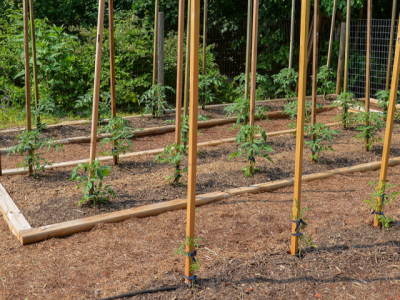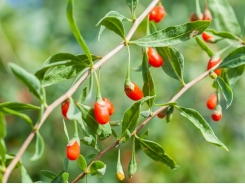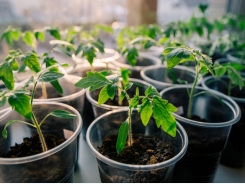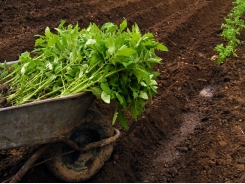How to Grow Your Own Tomatoes, Part 3: Staking, Training and Pruning

Tomato beds have an unfair reputation as the messiest, ugliest, most disease-ridden parts of a vegetable garden. To keep them from devolving to this sorry state, tomato plants need your care and support. More specifically, they need the support of a trellis, stake or cage, and they need you to train them to grow on it while primping and pruning their vines into a respectable form. If you do, the plants will be healthier and more productive and more presentable when you’re showing off your garden to visitors.
Image via Flickr user Mark Levisay
Support Structures
Before you get started, you need to know whether you have neat and compact determinate tomato plants or one of the more unruly indeterminate varieties. The former group consists of varieties that have been bred for stems that grow only to a specific length; many of the modern hybrid varieties fall into this category. The latter bunch is comprised primarily of older heirloom varieties, which are vine-like and will keep growing until freezing temperatures stop them. The back of the seed packet should indicate which you planted.
Store-Bought Wire Tomato Cages
The standard wire tomato cage found in garden centers (in the shape of a downward-tapering cylinder) is fine for small, bushy determinate varieties, but will quickly become overwhelmed by a large indeterminate plant.
Homemade Wire Cages
For a bigger, beefier cage, use a 5-foot-by-5-foot section of wire fencing or concrete reinforcing mesh. Roll it into a cylinder, set it over the top of a young tomato plant and anchor it into the ground with stakes on both sides. Use a product with grid openings that are at least 4 inches square (ideally 6 inches), so you can reach your hand in to prune, train and harvest.
Stakes
A single, stout stake is an effective support structure for a tomato plant. For small determinate varieties, use a 1-inch-by-1-inch-by-4-foot stake and pound it into the ground at least 6 or 8 inches deep near the base of the plant. For large tomato vines, use a 2-inch-by-2-inch-by-7-foot stake and pound it in at least 14 to 16 inches. If you can’t find stakes that come with a pointed tip on the bottom, cut a point yourself so they go in the ground more easily. Avoid pressure treated lumber, since it may leach toxic chemicals into the ground around your tomato plants.
Trellises
Tomatoes can be trained onto any number of trellises intended for other vines, including the farm-classic hog wire trellis. However, for a simple trellis to use for a single growing season, pound in a row of stakes along the center of your tomato bed and run horizontal lengths of twine between them. For small tomato varieties, use 1-inch by 1-inch by 4-foot stakes spaced every 4 to 6 feet and run the twine across every 6 inches. For larger varieties, use 2-inch-by-2-inch-by-7-foot stakes spaced every 6 to 8 feet and run the twine across every 12 inches.
An alternative method is to stretch bailing wire horizontally across the tops of the stakes and run a piece of twine vertically from the bailing wire down to each plant, anchoring it at the bottom by tying it to a short wooden stake.
Pruning and Training
Training tomatoes is not difficult, but you have to start when they’re young. Wait no more than a month after transplanting.
Tie the stems of your tomato plants to the support structure every 6 or 8 inches as they grow. The growing stems are soft and easily damaged, so you need to tie them loosely. Use thick garden twine, plastic plant tape, strips of fabric or old pantyhose. It’s always better to tie just above a cluster of flowers rather than just below otherwise the stems holding the flowers may get crimped by the ties as the flowers turn into heavy clusters of fruit.
If you’re using the single-stake method or the single-string trellis method, you’ll want to train the tomato plants to a single stem. For the horizontal-string trellis method or the cage method, three or four stems works best. It’s best to decide on a method before planting the tomatoes, because they can be spaced much closer together if they will be trained to a single stem, versus those with multiple stems, which need to branch out over a larger area.
As the original stem grows, it will begin to sprout side stems often called ‘suckers’ in the crotches between the leaves and the main stem. To maintain a single stem, prune out all suckers as they appear. For multiple stems, let the first few suckers that appear grow into stems of their own and prune out subsequent suckers. To prune, simply snap off the sucker with your fingers just above the point where it joins the main stem. They are succulent and easy to snap when they first appear, and it’s best to avoid cutting them with scissors or pruners, which may contain diseases or other harmful organisms on their blades.
If you’re using a multi-stem approach, tie those stems to the support structure in the same manner as the original stem. Continue to remove suckers throughout the growing season, both from the original stem and the side stems.
About one month before the average date of first frost, there is one last pruning chore: cut off the ends of each stem just above the topmost fruit cluster. It may seem severe, but cutting the growing tips forces the plants to put a final burst of energy toward ripening the fruit that is left on the vine while the weather is still warm.
Related news
Tools

Phối trộn thức ăn chăn nuôi

Pha dung dịch thủy canh

Định mức cho tôm ăn

Phối trộn phân bón NPK

Xác định tỷ lệ tôm sống

Chuyển đổi đơn vị phân bón

Xác định công suất sục khí

Chuyển đổi đơn vị tôm

Tính diện tích nhà kính

Tính thể tích ao




 How to Grow Your Own Tomatoes Part 4:…
How to Grow Your Own Tomatoes Part 4:…  How to Grow Your Own Tomatoes, Part 2:…
How to Grow Your Own Tomatoes, Part 2:…